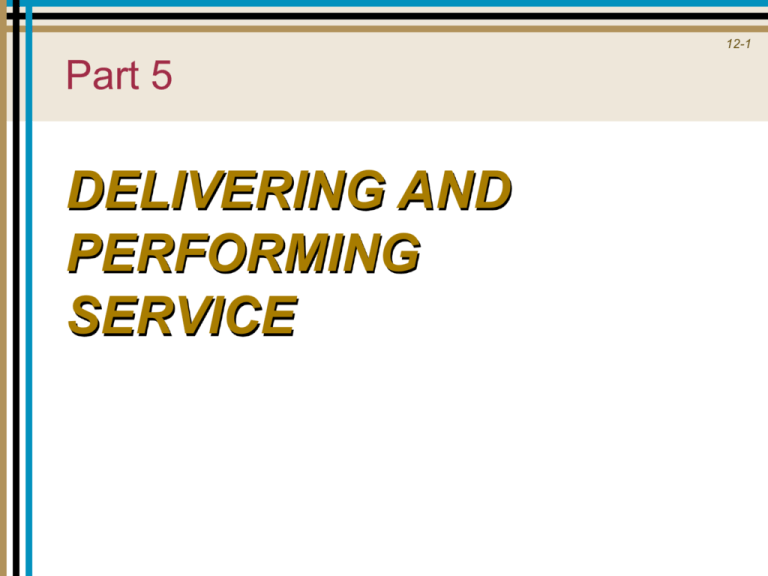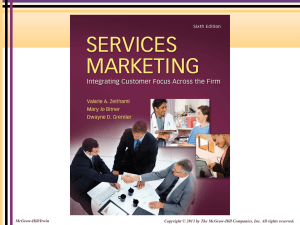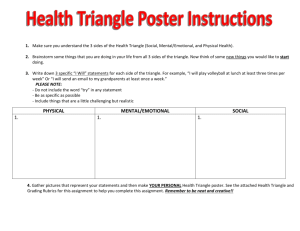
12-1
Part 5
DELIVERING AND
PERFORMING
SERVICE
12-2
Provider Gap 3
12-3
Key Factors Leading to Provider Gap 3
Employees’ Roles in Service
Delivery
Chapter12-4
12
Service Culture
The Critical Importance of Service
Employees
Boundary-Spanning Roles
Strategies for Delivering Service Quality
Through People
Customer-Oriented Service Delivery
McGraw-Hill/Irwin
Copyright © 2009 by The McGraw-Hill Companies, Inc. All rights reserved.
Objectives for Chapter 12:
Employees’ Roles in Service Delivery
12-5
Demonstrate the importance of creating a service culture
in which providing excellent service to both internal and
external customers is a way of life.
Illustrate the pivotal role of service employees in creating
customer satisfaction and service quality.
Identify the challenges inherent in boundary-spanning
roles.
Provide examples of strategies for creating customeroriented service delivery through hiring the right people,
developing employees to deliver service quality,
providing needed support systems, and retaining the
best service employees.
12-6
Service Culture
“A culture where an appreciation for good
service exists, and where giving good
service to internal as well as ultimate,
external customers, is considered a natural
way of life and one of the most important
norms by everyone in the organization.”
- Christian Grönroos (1990)
The Critical Importance of Service
Employees
They are the service.
They are the organization in the customer’s eyes.
They are the brand.
They are marketers.
Their importance is evident in:
the services marketing mix (people)
the service-profit chain
the services triangle
12-7
12-8
The “Power of One”
Every encounter counts
Employees are the service
Every employee can make a difference
Through their actions, all employees shape
the brand
12-9
The Services Marketing Triangle
12-10
Aligning the Triangle
Organizations that seek to provide
consistently high levels of service excellence
will continuously work to align the three
sides of the triangle.
Aligning the sides of the triangle is an
ongoing process.
Services Marketing Triangle
Applications Exercise
12-11
Focus on a service organization. In the context
you are focusing on, who occupies each of the
three points of the triangle?
How is each type of marketing being carried out
currently?
Are the three sides of the triangle well aligned?
Are there specific challenges or barriers in any of
the three areas?
12-12
Making Promises
Understanding customer needs
Managing expectations
Traditional marketing communications
Sales and promotion
Advertising
Internet and web site communication
12-13
Keeping Promises
Service delivery
Reliability, responsiveness, empathy, assurance,
tangibles, recovery, flexibility
Face-to-face, telephone & online
interactions
The Customer Experience
Customer interactions with sub-contractors
or business partners
The “moment of truth”
12-14
Enabling Promises
Hiring the right people
Training and developing people to deliver
service
Employee empowerment
Support systems
Appropriate technology and equipment
Rewards and incentives
Ways to Use the
Services Marketing Triangle
Overall Strategic
Assessment
How is the service
organization doing on all
three sides of the
triangle?
Where are the
weaknesses?
What are the strengths?
12-15
Specific Service
Implementation
What is being promoted
and by whom?
How will it be delivered
and by whom?
Are the supporting
systems in place to
deliver the promised
service?
12-16
The Service Profit Chain
12-17
Service Employees
Who are they?
“boundary spanners”
What are these jobs like?
emotional labor
many sources of potential conflict
person/role
organization/client
interclient
quality/productivity tradeoffs
Boundary Spanners Interact with Both
Internal and External Constituents
12-18
12-19
Boundary-Spanning Workers Juggle Many
Issues
Person versus role
Organization versus client
Client versus client
12-20
Human Resource Strategies for Delivering
Service Quality through People
12-21
Empowerment
Benefits:
quicker responses to
customer needs during
service delivery
quicker responses to
dissatisfied customers during
service recovery
employees feel better about
their jobs and themselves
employees tend to interact
with warmth/enthusiasm
empowered employees are a
great source of ideas
great word-of-mouth
advertising from customers
Drawbacks:
potentially greater dollar
investment in selection and
training
higher labor costs
potentially slower or
inconsistent service delivery
may violate customers’
perceptions of fair play
employees may “give away
the store” or make bad
decisions
12-22
Seattle’s CLICK!
12-23
Traditional Organizational Chart
Manager
Supervisor
Front-line
Employee
Front-line
Employee
Front-line
Employee
Supervisor
Front-line
Employee
Front-line
Employee
Customers
Front-line
Employee
Front-line
Employee
Front-line
Employee
12-24
Customer-Focused Organizational Chart
12-25
Inverted Services Marketing Triangle
12-26
How Employee Satisfaction Drives Productivity
and Customer Satisfaction at Wegmans
The grocery chain paid over $54 million for
college scholarships for 17,500+ employees
over the past 20 years.
Wegmans did not hesitate to send cheese
manager Terri Zodarecky on a ten-day
sojourn to cheesemakers in Europe.
The firm gives employees flexibility to
deliver great customer satisfaction.
How can this be justified?
12-27
How does this affect performance?
Wegmans’ labor costs are 15-17% of
sales, compared with 12% for industry.
But annual turnover is just 6% (19% for
similar grocery chains).
20% of employees have 10+ years of
service.
This in an industry where turnover
costs can exceed annual profits by
more than 40%.
Wegmans’ operating margins are
7.5%, double what the big grocers
earn.
Sales per square foot are 50% higher
than industry average.








